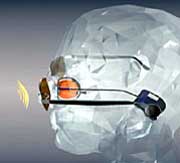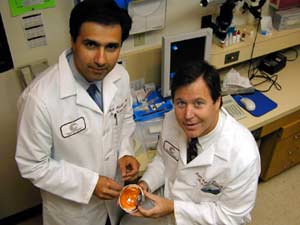 |
A camera that transmits images to the brain could give those with visual impairments or blindness a chance to regain some sight. The images have been tested at the Doheny Retina Institute.
A New Vision
Typically, when light rays or images are focused by the lens of the eye onto the retina, light-sensitive cells known as “rods” and “cones” convert this light into electrical impulses that are sent to the brain, allowing us to perceive the world around us. “The retina actually performs some image processing functions and then sends this information to the brain, and that’s how we see” – explains Mark.
Retinal Chip Implant
 |
|
Mark Humayun (left) & Eugene de Juan, Professor of Ophthalmology at Keck School of Medicine |
Humayun, a Professor of Ophthalmology at the Keck School of Medicine and Director of Research at the Doheny Retina Institute, is currently working on a type of artificial retina that he hopes can restore some vision to those blinded by retinal cell degeneration. “Once vision is lost and patients cannot see, it becomes very difficult to treat, and there’s often nothing left to restore their sight” – Humayun states – “The goal is to restore lost vision through this retinal implant.”
Researchers have focused on blindness caused by retinal degeneration due to retinitis pigmentosa (RP) and age-related macular degeneration (AMD). RP is the term for a group of genetic eye diseases that damage cells around the edge of the retina, gradually leading to what is known as “tunnel vision.” AMD, on the other hand, damages cells at the center of the eye, creating a dark spot in the center of a person’s vision, making their sight blurry and wavy, or completely blind, with the condition progressively worsening. Therefore, the retinal implant or chip aims to provide peripheral vision for those with RP and central vision for those with AMD.
Tiny Electric Pulses to the Retinal Implant
When the retinal implant project began nearly 17 years ago, scientists also started researching cochlear implants. Instead of converting sound into electrical impulses, Humayun and his colleagues capture images and convert them into tiny electrical pulses to stimulate the retina. “The idea behind this retinal implant is that when the light-sensitive cells are destroyed, you can use a camera to convert images into tiny electrical pulses to then stimulate the remaining cells in the retina” and enable sight – he explains.
Currently, their “Model 1” implant, developed by California-based Second Sight Medical Products, has been implanted in six patients. Measuring 4x5mm, this electronic retinal stimulating chip consists of a piece of silicon and platinum with 16 electrodes, implanted at the back of the eye above the retina. The images captured by a lightweight miniature video camera attached to glasses are transmitted wirelessly as tiny electrical pulses to a receiver hidden behind the patient’s ear. “When these electrodes stimulate the retina, this information is sent to the brain, allowing the patients to see” – Humayun concludes.


















































